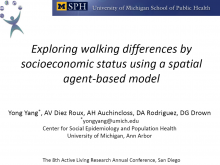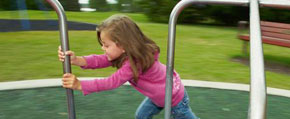We are pleased to announce an exciting new alliance between Active Living Research and GP RED to co-host and coordinate...
Exploring Walking Differences by Socioeconomic Status Using a Spatial Agent-Based Model

Presentation at the 2011 Active Living Research Annual Conference
Background:
Walking is known to be patterned by a number of individual-level characteristics including socioeconomic characteristics. The contribution of built and social environments to socioeconomic status (SES) differences in walking has been infrequently investigated.
Objectives:
The first objective of this study was to develop an agent-based model that can be used to enhance the study of the environmental effects of walking in an urban area. The second objective was to use the model to explore how built and social environment characteristics contribute to SES differences in walking in the context of a dynamic system.
Methods:
A spatial agent-based model was developed to simulate peoples’ walking behaviors within a city at the individual level. Each individual is assigned properties such as age, SES, walking ability, attitude towards walking and a home location in the city. Individuals perform different activities on a regular basis such as traveling for work, for shopping, and for recreation. Whether people walk and the amount they walk as they perform these activities is a function of environmental properties such as distances to the different activities and individual’s internal properties such as attitude towards walking. An individual’s attitude towards walking evolves over time as a function of their past experiences, presence of other walkers within the neighborhood, limits on distances walked per day, and attitudes towards walking of the other persons within her/his social network. The model was calibrated to data on number and distance of walking trips reported in NHTS data.
In order to explore the contribution of built and social environment characteristics to SES differences in walking we contrasted four scenarios. All scenarios had identical levels of residential segregation by SES, such that lower SES households are located in the center of the city and higher SES households in the periphery. The four scenarios on two dimensions: (1) spatial distribution of non-household locations; and (2) spatial distribution of safety.
Results:
In scenario RR (random distribution of land use and safety), the difference in walking trips between SES groups was small. For scenario CR (central location of non residential land use, random distribution of safety), there was an SES gradient in walking trips such that lower SES groups walked more than higher SES groups. This was because lower SES groups lived within the zone with higher density of non-household locations. In scenario RS (random mix of land uses and spatial segregation of safety such that safety levels increase outwards) walking trips decreased over time in the lower SES groups but increased over time in the higher SES groups. However, in scenario CS, which combined spatial patterning of safety and land use such that the central areas (with lower SES) had greater mix of uses and lower safety, the beneficial effects of proximity of destinations on walking in the lower SES groups was reduced over time because of the adverse effects of lack of safety.
Examination of walking for different purposes by SES in scenario CS showed that lower SES groups walked more than the higher SES groups for work (due to their proximity to work destinations), and less than the higher SES groups within the neighborhood (due to the impact of safety). For basic needs trips, walking levels were similar across SES groups due to the counteracting effects of proximity to destinations and safety.
Conclusions:
Our results show that the co-spatial segregation of SES and safety, such that low SES neighborhoods have low safety, can result in SES patterning of walking even when SES is not spatially correlated with land-use mix. The simulations also suggest that when lower SES individuals live in areas with greater proximity to destinations, they tend to walk more than high SES individuals, but this advantage can be neutralized when low SES areas are also low in safety. This interplay between land use and safety can create very different SES patterns for different types of walking. Although the associations of greater mixed land use and more safety with more walking are a direct function of the model rules, the SES patterning of walking or the way in which this patterning changes over time as a function of the spatial co-location of SES, land use and safety, as well as the differential SES pattering of different types of walking, was not directly encoded in the model. Our model therefore shows how theses SES differences can emerge even in the context of similar starting walking preferences by SES. The dynamics of these processes are difficult to capture with statistical models alone.
Support:
This study was supported in part by a pilot program from the Center for Social Epidemiology and Population Health at the University of Michigan (by R24 HD047861) and by the Robert Wood Johnson Health and Society Scholar’s program.
STAY UP TO DATE
RECENTLY ADDED TOOLS & RESOURCES
MOVE! A BLOG ABOUT ACTIVE LIVING
The "Active Living Conference" aims to break down research and practice silos and...







